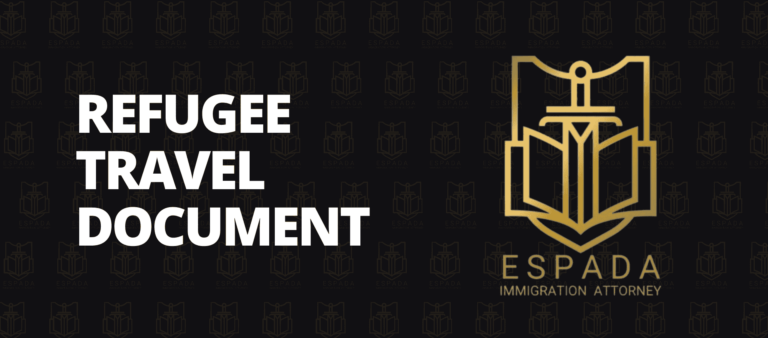Refugee Travel Document: A Comprehensive Guide to the Refugee Travel Document

If you are in the United States on refugee or asylum status, and you wish to travel outside of the country, you will need to apply for a refugee travel document. This travel document is a small booklet, similar to a passport, and it allows refugees and asylees to reenter the United States after traveling abroad. Leaving the U.S. without a refugee travel document could result in being unable to return or even facing removal proceedings.
In this guide, I will walk you through the process of applying for a refugee travel document. If you have any questions, feel free to contact me directly at abbas@espadaimmigration.com.
Overview:
- What is a Refugee Travel Document and Why Do You Need One?
- Who is Eligible to Apply for a Refugee Travel Document?
- What are the Requirements to Get a Refugee Travel Document?
- How to Apply for a Refugee Travel Document (Step-by-Step)
- How Long is a Refugee Travel Document Valid For?
- Refugee Travel Document Processing Time
- Is There Any Way to Speed-Up the Refugee Travel Document Processing Time?
- What Documents to Submit with Your Refugee Travel Document Application
- What is the Refugee Travel Document Fee?
- Traveling Back to the Country of Claimed Persecution
- Conclusion
1. What is a Refugee Travel Document and Why Do You Need One?
A refugee travel document is a small booklet similar to a passport, containing several pages. It can be used as a substitute for a passport in certain circumstances. If you are lawfully present in the United States as a refugee or asylee and you intend to travel internationally, you will need a refugee travel document to re-enter the U.S. Without it, you might face difficulties reentering the country and may even be subject to removal proceedings.
It is important to note that possessing a refugee travel document does not guarantee re-admittance to the United States. You must still undergo inspection by a Customs and Border Protection (CBP) officer when re-entering the country.
2. Who is Eligible to Apply for a Refugee Travel Document?
-
Individuals in refugee or asylum status:
Refugees and individuals granted asylum are eligible to apply for a refugee travel document. -
Lawful permanent residents with refugee or asylum status:
Those who have obtained their lawful permanent resident status as a refugee or asylee in the U.S. are also eligible.
3. What are the Requirements to Get a Refugee Travel Document?
1. Must be a refugee, asylee, or lawful permanent resident
To apply for a refugee travel document, you must be in the U.S. with refugee or asylum status, or you must have obtained your permanent resident status as a refugee or asylee. If you have applied for refugee or asylum status but have not yet received approval, you are not eligible for a travel document. If you hold any other status, you will not qualify.
2. Must be physically present in the U.S. when your application is filed
You must be in the U.S. when your application for a refugee travel document is submitted, received, and accepted by USCIS. Additionally, you should remain in the U.S. until your biometrics (fingerprinting) appointment is completed. Leaving the U.S. before your biometrics appointment could result in your case being denied.
In certain situations, you may be able to apply for a refugee travel document if you are outside the U.S., but only if your application is submitted within one year of your last departure from the country. If you apply from abroad, you must provide a justification for why you left the U.S. without applying for a travel document. The USCIS Overseas District Director in your region will decide whether to approve or deny your application. Therefore, it is advisable to apply for a refugee travel document before departing the U.S.
3. Must file Form I-131, submit supporting documents, and attend a biometrics appointment
To apply for a refugee travel document, you must submit Form I-131 (Application for Travel Document) to USCIS along with the necessary supporting documents. Additionally, you must attend a mandatory biometrics appointment to provide digital fingerprints as part of the application process.
4. How Long is a Refugee Travel Document Valid For?
A refugee travel document is valid for one year from the date of issuance.
5. How to Apply for a Refugee Travel Document (Step-by-Step)
Step 1: File Form I-131 Along with Supporting Documents
To begin the application process, you must file Form I-131 with USCIS. The Form I-131 is an application for a travel document. As mentioned earlier, it is recommended that you be physically present in the U.S. when filing this form to reduce the chances of your application being denied.
Step 2: Attend Biometrics Appointment
After submitting Form I-131, USCIS will send you a notice to attend a mandatory biometrics appointment. At this appointment, your digital fingerprints will be collected. This is a required step to obtain a refugee travel document.
For further assistance with your application or to learn more about the process, feel free to contact Espada Immigration at abbas@espadaimmigration.com.
6. Refugee Travel Document Processing Time
This answer is best divided into four separate segments:
1. Issuance of USCIS Receipt Notice (1 to 3 Weeks from Filing)
Once you submit Form I-131 with USCIS, you will receive a receipt notice. This notice serves as confirmation that USCIS has received and accepted your application. The notice will also include a unique receipt number, which you can use to track the progress of your case through the USCIS case status checker. Typically, you should expect to receive the receipt notice within 1 to 3 weeks after filing the refugee travel document application.
2. Issuance of Biometrics Appointment Notice (6 Weeks from Filing)
Approximately six weeks after submitting your refugee travel document application, USCIS will send you a biometrics appointment notice. This notice will provide the date, time, and location of your biometrics appointment, along with instructions on what you need to bring. If needed, you can reschedule your appointment by following the guidelines outlined in the notice.
3. Biometrics Appointment Date (8 Weeks from Filing)
The biometrics appointment will typically take place about 8 weeks after filing the refugee travel document application. Be sure to bring a valid form of identification and the actual biometrics appointment notice with you to the appointment, along with any other documents specified in the notice.
4. Issuance of Refugee Travel Document (2 to 5 Months from Filing)
You can expect to receive your refugee travel document approximately 2 to 5 months after filing Form I-131. You will have the option to have the document sent to your U.S. address, a U.S. consulate or embassy abroad, or your immigration lawyer’s office (if you are working with one).
It’s important to note that you are not required to stay in the U.S. until you receive the physical travel document. After completing your biometrics appointment, you may leave the country and have the travel document sent to a U.S. consulate or embassy abroad.
7. Is There Any Way to Speed-Up the Refugee Travel Document Processing Time?
Yes, in certain circumstances, USCIS may expedite the processing of your refugee travel document application. USCIS has specific criteria for expedited processing, which are determined on a case-by-case basis. Below are some scenarios that may justify expedited processing:
- Emergency situations
- Severe financial loss to an individual or company
- Errors made by USCIS
- Cases with compelling USCIS interest
- Humanitarian reasons
USCIS has discretion over whether or not to expedite a case, and expedited requests are granted on a case-by-case basis.
8. What Documents to Submit with Your Refugee Travel Document Application
The documents required for your refugee travel document application may vary based on your specific case. However, here are some general documents you will likely need to include:
- A copy of a valid government-issued photo I.D. (such as a passport, lawful permanent resident card, or driver’s license)
- A copy of USCIS documentation showing your status as a refugee or asylee, including the expiration date of that status
- Two passport-sized photos
9. What is the Refugee Travel Document Fee?
There are two fees involved when applying for a refugee travel document:
- I-131 Filing Fee: $135 for individuals aged 16 and older; $105 for individuals under 16.
- Biometrics Fee: $85 (this fee applies only to individuals between the ages of 14 and 79).
10. Traveling Back to the Country of Claimed Persecution
Returning to your country of claimed persecution can have serious consequences on your refugee or asylum status in the U.S.
If you are granted asylum in the U.S. and travel back to your country of claimed persecution, your asylum status may be revoked. Such travel could be interpreted as a change in the circumstances surrounding your asylum approval or as evidence that your fear of persecution is no longer genuine. Furthermore, returning to your country might indicate that you have voluntarily accepted the protection of your home country.
Given these potential risks, it is highly recommended that you avoid traveling back to your country of claimed persecution.
11. Conclusion
A refugee travel document is essential if you are in refugee or asylum status in the U.S. and plan to leave the country. Without it, you risk being unable to return to the U.S. or facing removal proceedings. For these reasons, obtaining a refugee travel document is crucial. If you need assistance with your refugee travel document application, feel free to contact me directly at abbas@espadaimmigration.com. I am an immigration lawyer at Espada Immigration and would be happy to help you.
Resources:
- USCIS Expedite Criteria
- INA Act 208 – Asylum
- USCIS Case Status Tracker
- USCIS – Form I-131
- USCIS Fact Sheet on Traveling Outside the U.S. as an Asylum Applicant, Asylee, or Lawful Permanent Resident Who Obtained Status Based on Asylum
- I-131 Instructions
Why Choose Us
Choosing the right immigration lawyer can make all the difference in achieving your U.S. immigration goals. At Espada Immigration Lawyer, we are dedicated to providing exceptional legal guidance and personalized support through every step of the process. Our team combines specialized expertise, transparency, and an unwavering commitment to client success, making us a trusted partner for all your immigration needs.
- Specialized Expertise
- Personalized Approach
- Transparent Guidance
- Client-Centered Commitment

DISCLAIMER: This article is provided for general informational purposes only and does not constitute legal advice. The information herein should not be interpreted as formal legal counsel nor does it establish an attorney-client relationship. This article is neither intended as a solicitation for legal services nor as a substitute for individual legal advice. For specific legal guidance, please consult an attorney in your jurisdiction. Actions based on information in this article are taken at your own risk, and I disclaim any liability for such actions. Please note that information may have changed since publication and may no longer be current. This article does not offer guarantees, warranties, or predictions regarding the outcome of any legal matters. Each case is unique, and results will depend on individual facts and legal issues. Thank you.
ATTORNEY ADVERTISING: Any invitation to contact our law firm on this website and related pages constitutes attorney advertising.
